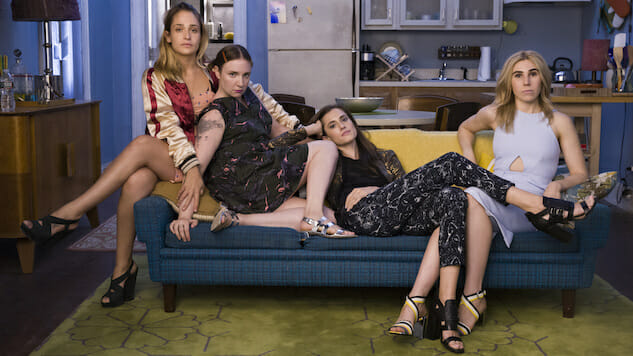
Note: This piece is the TV Essential in Paste Quarterly #1, which you can purchase here, along with its accompanying vinyl Paste sampler.
Before Shoshanna Shapiro (Zosia Mamet) inadvertently smokes crack—“It was a glass cigarette and I’m high,” she explains—the warehouse in Bushwick where “The Crackcident” happens bristles with unruly emotions. As the night wears on, silent resentments spill into sudden arguments, unspoken affections into romantic acts, but the episode’s profound ambivalence, like that of the series still finding its voice, is right there from the start. As Shosh says to her cousin, Jessa (Jemima Kirke), after spending two hours at the party without speaking to anyone, “I’m so happy to see you I could murder you,” and in this she describes, with uncanny precision, how it’s always felt to love Girls.
As HBO’s challenging, even controversial series, from creator Lena Dunham, approaches the end of its sixth and final season, its frustrations (the shiftless plotting, the barbed characterization) now appear instrumental to its group portrait of an age—meaning both a particular stage of life, one’s mid-twenties, and a particular cultural moment, our own. Girls, it turns out, is an intricate timepiece: Its finest entries, from the first season’s “Welcome to Bushwick, aka The Crackicdent” to the fifth season’s sublimely disenchanting “The Panic in Central Park,” condense the action to a single night, or perhaps—as in “The Return,” “One Man’s Trash,” and “Flo”—a longish weekend, while the entire series, as Dunham told Fresh Air’s Terry Gross in 2014, covers no more than two or three years. In short, it renders literal that all-too-familiar phrase, “slice of life,” and then focuses on each fragment with uncommon ardor.
If this once left the viewer to fight off a sense of stasis, the growing gulf between Dunham and her character, aspiring writer Hannah Horvath, has since lent Girls its distinctive Vertigo effect, zooming in on the naive, often narcissistic foibles of being 24 or 25 as Dunham, now 30, dollies away. In what may be the series’ most crucial episode, the fourth season’s brittle, brilliant “Sit-In,” stalwart director Richard Shepard and writers Paul Simms and Max Brockman at first seem to revel in the characters’ self-pity. When Hannah returns to New York from a stint at the Iowa Writers’ Workshop to find that her boyfriend, Adam (Adam Driver), has taken up with a successful artist named Mimi-Rose Howard (Gillian Jacobs), she stages the titular protest by holing up in her former bedroom, and as her friends drop in, one by one, to coax her from hiding, the conversation moulds itself to each interlocutor’s problems.
Shosh feels left out, Jessa abandoned; the curmudgeonly Ray (Adam Karpovsky) complains of the city’s minor injustices; the exquisitely insensitive Marnie (Allison Williams) brags of her burgeoning relationship with Desi (Ebon Moss-Bachrach). The result is a bitterly funny, kaleidoscopic treatment of our blinkered points of view—what Joan Didion, preeminent essayist of another age, called “the implacable ‘I’”—that tends, in its final act, toward regret. After Hannah and Adam arrive at a kind of understanding, or at least a brief détente, she retreats to the storage unit where he’s placed her stuff, and “Sit-In” emerges as an empathic reminder that the heretofore unacknowledged constant in Hannah’s frayed relationships is herself: “And we broke/everything that was right,” Lucy Rose sings as the episode reaches its expectant final image, of an open door and a tattered suitcase. “We both enjoyed a good fight.”
That soft, sorrowful “we” has since become the axis around which Girls spins, widening the frame to find Shosh at loose ends in Tokyo, or Marnie and her ex, Charlie (Christopher Abbott), trying (and ultimately failing) to rekindle the flame. More dreamlike than ever, marked by home births, foreign excursions, on-the-fly aliases, and experimental theatre, the series pulls off its most complex chronological feat, which is to capture the central paradox of growing up: to feel, indeed to fear, that everything changes, even as you remain stuck. This is, of course, just a trick of perspective, but in its halting rhythms—two steps forward, one step back—Girls reflects the work of evolving, of maturing, of finding one’s voice. As Hannah grasps, however briefly, in the fifth season’s lovely finale, to be “a voice of a generation,” as she puts it in the pilot episode, is not to mimic another’s, but to nurture and to cultivate one’s own. “I’m Hannah forever,” she admits near the end of her performance at a Moth story slam. “No matter what I do.”
In the final estimation, then, Girls redirected the searching, occasionally bleak humor of Louie toward characters rarely treated as subjects in TV’s “auteurist” comedies—an attempt to reinvent the pilot’s points of reference (The Mary Tyler Moore Show, Sex and the City) for another age. That it’s been more successful in this regard than it receives credit for might be suggested by the series with which it shares an aesthetic or narrative kinship, from HBO’s more naturalistic Looking and its gonzo successor, Search Party, to its more inclusive and consistent counterparts, such as Issa Rae’s Insecure and Donald Glover’s Atlanta. Girls is essential because of its imperfections, which of course approximate our own—and because, in squaring space on TV for the shiftless and the barbed, the selfish and the sorrowful, it counts among the decade’s most influential series. Warts and all.
Girls airs Sunday nights at 10 p.m. on HBO.
Matt Brennan is the TV editor of Paste Magazine. He tweets about what he’s watching @thefilmgoer.